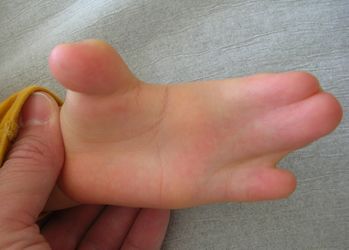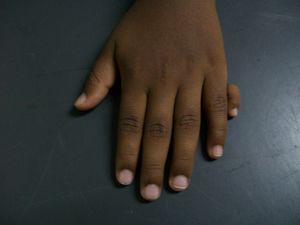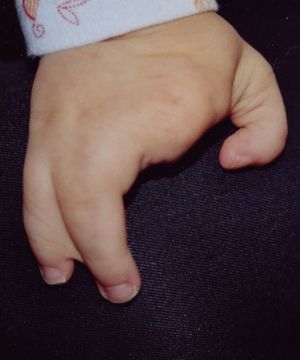Congenital Hand Deformities
Original Editor - Shwe Shwe U Marma
Top Contributors - {{Special:Contributors/Template:Congenital Hand Deformities}}
This article is currently under construction and may only be partially complete. Please come back soon to see the finished work. Thank you! (11/10/2020)
Introduction[edit | edit source]
Congenital hand deformities are deformities of the hand that develop in a child before birth.[1] Congenital hand deformities are also known as- congenital hand differences[2], congenital hand anomalies[3], congenital hand conditions[4] and congenital hand problems[5].
Etiology[edit | edit source]
Congenital hand deformities usually occur between the fourth and eighth week after the embryo is formed. Failure of the transformation from arm bud cells to the upper limb can lead to an abnormal appearing/functioning upper extremity which is presented at birth. Some causes are linked to genetics while others are affected by the environment, and the rest have remained unknown.[6]
Epidemiology[edit | edit source]
Of the 1% to 2% of newborns that are born with congenital defects, 10% of these are born with upper extremity malformations.[7] Congenital hand deformities affect approximately 1 in 500 persons and present unique diagnostic and classification challenges[8].
Classification[edit | edit source]
The Oberg, Manske, Tonkin (OMT) classification describes 3 groups of congenital hand deformities.[1][9]
- Malformations: Malformations are abnormalities of formation and/or differentiation of the tissues. Examples include- brachydactyly, symbrachydactyly, syndactyly, polydactyly, cleft hand/ectrodactyly, apert hand etc.
- Deformations: Deformations are abnormalities which occur after tissue is formed. Examples include- constriction ring sequence, trigger digits etc.
- Dysplasias: Dysplasias are abnormalities that result from a lack of normal organization of cells into tissue. Examples include- hemihypertrophy, macrodactyly, osteochodromatosis, fibrous dysplasia etc. [9]
Complications[edit | edit source]
Surgical Management[edit | edit source]
Physiotherapy[edit | edit source]
Resources[edit | edit source]
References[edit | edit source]
- ↑ 1.0 1.1 Oberg KC. Classification of congenital upper limb anomalies: towards improved communication, diagnosis, and discovery. Journal of Hand Surgery (European Volume). 2019 Jan;44(1):4-14.
- ↑ Sullivan MA, Adkinson JM. Congenital hand differences. Plastic Surgical Nursing. 2016 Apr 1;36(2):84-9.
- ↑ Gishen K, Askari M. Congenital hand anomalies: etiology, classification, and treatment. Journal of Craniofacial Surgery. 2014 Jan 1;25(1):284-94.
- ↑ Oda T, Pushman AG, Chung KC. Treatment of common congenital hand conditions. Plastic and reconstructive surgery. 2010 Sep;126(3):121e.
- ↑ Netscher DT. Congenital hand problems. Terminology, etiology, and management. Clinics in plastic surgery. 1998 Oct 1;25(4):537-52.
- ↑ Peng H, Wang X, Duan Y, Frey SH, Gu X. Brain morphometry on congenital hand deformities based on Teichmüller space theory. Computer-Aided Design. 2015 Jan 1;58:84-91.
- ↑ Linder JM, Pincus DJ, Panthaki Z, Thaller SR. Congenital anomalies of the hand: an overview. Journal of Craniofacial Surgery. 2009 Jul 1;20(4):999-1004.
- ↑ Sammer DM, Chung KC. Congenital hand differences: embryology and classification. Hand clinics. 2009 May 1;25(2):151-6.
- ↑ 9.0 9.1 Tonkin MA. Classification of congenital anomalies of the hand and upper limb. Journal of Hand Surgery (European Volume). 2017 Jun;42(5):448-56.









